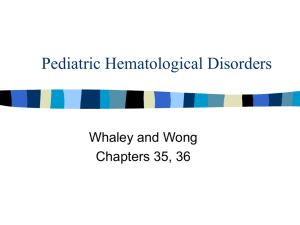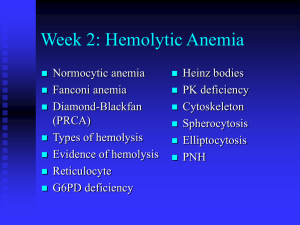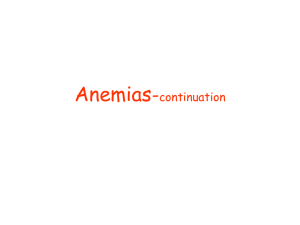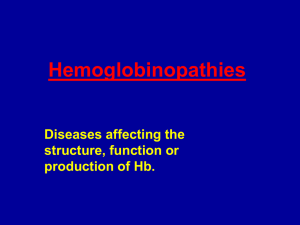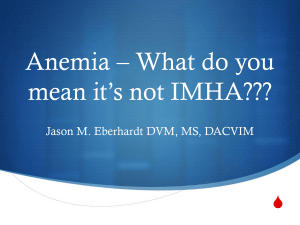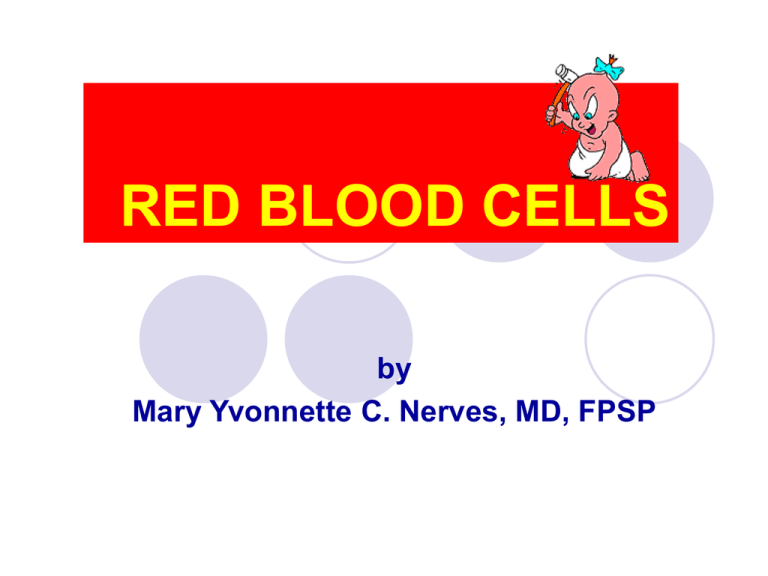
RED BLOOD CELLS
by
Mary Yvonnette C. Nerves, MD, FPSP
Erythropoiesis
A process by which early erythroid
precursor cells differentiate to become
the mature RBCs
Primary regulator: ERYTHROPOIETIN
- stimulates red cell precursors at all levels of
maturation to hasten the maturation process
- responsible for stimulating the premature release
of reticulocytes into the bloodstream.
Erythropoiesis
Total erythropoiesis:
- total number of red blood cells (RBCs)
- measured by the myeloid-erythroid (M:E)
ratio from aspirate smears plus the
estimate of cellularity from biopsy sections
Effective erythropoiesis:
- number of viable and functional RBCs
available for physiologic needs
- reflects the balance between the number of
cells produced and their life span
- measured by the reticulocyte count, which
is normally 1% of the total RBC count
Stages of Maturation
1. Pronormoblast (Rubriblast)
2. Basophilic Normoblast (Prorubriblast)
3. Polychromatophilic Normoblast
(Rubricyte)
4. Orthochromatic Normoblast
(Metarubricyte)
5. Reticulocyte
6. Erythrocyte
Pronormoblast
Earliest recognizable and largest cell of the
erythrocyte series
Morphology:
- Size: 12 – 20 um
- Nucleus: large round, oval, dark violet; fine
chromatin; 1 – 2 nucleoli
- Cytoplasm: deep blue spotty, basophilic
w/ a perinuclear halo
- N/C Ratio: 8:1
- BM (%): 1
Basophilic Normoblast
Hemoglobin synthesis begins at this stage
Morphology:
- Size: 10 – 15 um
- Nucleus: large round to sl oval; condensed,
coarse chromatin; 0 – 1 nucleoli
- Cytoplasm: deeply basophilic; clusters of
free ribosomes
- N/C Ratio: 6:1
- BM (%): 1-4
Polychromatic Normoblast
Increased production of hemoglobin
pigmentation and decreasing amounts of
RNA
Last stage in which the cell is capable of
mitoses
Morphology:
- Size: 10 - 15 um
- Nucleus: round nucleus, deep staining, may
be centrally or eccentrically located;
coarse & clumped chromatin
- Nucleoli: 0
Morphology:
- Cytoplasm: abundant blue-gray (RNA) to
pink-gray (hemoglobin)
- N/C Ratio: 4:1
- BM (%): 10-20
Orthochromatic Normoblast
The last nucleated stage
Cannot synthesize DNA and cannot undergo
cellular division
The NRBC sometimes seen in the peripheral
circulation
Morphology:
- Size: 8 - 10 um
- Nucleus: small pyknotic nucleus; dense
chromatin; 0 nucleoli
- Cytoplasm: abundant red-orange cytoplasm
uniform in color
- N/C Ratio: 1:2
- BM (%): 5-10
Reticulocyte
Slightly larger than the mature RBC with
residual amts of RNA
Reticulocyte count: an index of bone marrow
activity or effective erythropoiesi
Morphology:
- Size: 8 - 10 um
- Nucleus: anucleate cell containing small
amt of basophilic reticulum (RNA)
- Nucleoli: 0
- Cytoplasm: large amt of blue-pink staining
hemoglobin cytoplasm
Erythrocyte
A biconcave 6 – 8 um disc
Life span: 120 days
Main function: to transport hemoglobin, a
protein that delivers oxygen from the lungs
to tissues and cells
Contains 90% hemoglobin and 10% H2O
normal conc of RBCs varies w/ age, sex &
geographic distribution
Morphology:
- Size: 7 - 8 um
- Nucleus: anucleated cell
- Nucleoli: 0
- Cytoplasm: pink staining, zone of central
pallor is 1/3 of cell diameter
devoid of hemoglobin
- N/C Ratio: NA
Hemoglobin: Structure & Function
A conjugated protein that serves as the vehicle
for the transportation of O2 and CO2
When fully saturated, each gram of Hgb can
hold 1.34 mL of O2
A molecule of Hgb consists of 2 pairs of
polypeptide chains (“globin”) and 4 prosthetic
heme grps each contg 1 atom of ferrous iron
DESCRIPTION of TERMS
SIZE DESCRIPTORS
Anisocytosis: variation in the sizeof the
RBCs due to a pathologic condition
Normocytic: normal sized biconcave disc
RBC
- normal MCV
Microcytic: Smaller RBCs less than 6 um
- MCV < 80 fl
- Defect / Change: abn size due to failure of
hgb synthesis
- Dse: IDA, Thalassemia, Chronic dse
Macrocytic: Larger RBCs greater than 9um
- MCV > 90 fl
- Defect / Change: impaired DNA synthesis /
stress erythropoiesis
- Dse: Megaloblastic anemia / liver dse /
MDS / Alcoholism / Malaria
Macrocytic
Microcytic
CHROMICITY DESCRIPTORS
Normochromic: normal in color; pale central
area occupies less than 1/3
- Defect / Change: normal amt of Hgb
- Normal indices
Hypochromic: an RBC that has a decreased
Hgb complement
- central pallor exceeds 1/3 of diameter of
cell
- Defect / Change: reduced Hgb content
( MCHC)
- Assoc conditions: IDA / Thalassemia
“Hyperchromic”: no central pallor
- Defect / Change: greater than normal
MCHC
- Assoc condition: Spherocytosis
“Hyperchromic”
Hypochromic
Polychromasia: blue-gray coloration
- Defect / Change: presence of RNA
- Assoc condition: increased erythropoietic
activity / hemorrhage /
hemolysis
SHAPE DESCRIPTORS
Poikilocytosis: variation in shape of the RBC
- Defect / Change: irreversible alteration of
membrane
- Assoc conditions: Anemia / Hemolytic
states
Discocyte: normal biconcave erythrocyte
- 6 – 8 um diameter; 0 – 2 um thickness
- Aka: Normocyte
Normal Red Cells (SEM)
Acanthocyte: spheroid w/ 3 – 12 irreg spikes
or spicules
- Aka: spur cell
- decreased cell volume
- Defect / Change: inc ratio of chole to
lecithin
- Assoc conditions:
end-stage liver dse
Pyruvate kinase def
Hemolytic anemia
Abetalipoproteinemia
Blister cell: contains 1 or more vacuoles
- Aka: Bite cells
- thinned periphery
- Defect / Change: formed by removal
of Heinz bodies
- Assoc conditions:
Hemolytic episodes
G6PD def
Hemoglobinopathies
Codocyte : peripheral rim of Hgb surr by
clear area & central hemoglobinized
area (bull’s eye)
- Aka: target cell
- Defect / Change: excess of surface to
volume ratio
- Assoc conditions:
Hemoglobinopathies
Thalassemia
Liver dse
Postsplenectomy
Dacryocyte: teardrop or pear-shaped w/
single elongated point or tail
- Aka: tear drop cell
- Defect / Change: squeezing &
fragmentation during splenic
passage
- Assoc conditions:
Myeloid metaplasia
Thalassemia
Megaloblastic anemia
Hypersplenism
Drepanocyte: crescent-shaped cell that
lacks zone of central pallor
- Aka: Sickle cell
- Defect / Change: polymerization of
deoxygenated Hgb
- Assoc conditions:
Sickle cell anemia
SC disease
S-thalassemia
Echinocyte: regular 10-30 scalloped short
projections evenly distributed / spiny-like
- Aka: Burr cell / crenated RBC
- Defect / Change: Depletion of ATP
Exposure to hypertonic soln
Artifact in air drying
- Assoc conditions:
Uremia
Cirrhosis / Hepatitis
Chronic renal dse
Ovalocyte: egglike or oval-shaped cell
- Defect / Change:
Hgb has bipolar arrangement
Reduction in membrane chole
- Assoc conditions:
Megaloblastic BM
Myelodysplasia
Sickle cell anemia
Elliptocyte: rod or cigar shape, generally
narrower than ovalocytes
- Defect / Change: polarization of Hgb
- Assoc conditions:
Thalassemia
Iron def
Hereditary elliptocytosis
Schistocyte: Fragmented RBCs varying
in size & shape
- Aka: Helmet cells
- Defect / Change: extreme fragmentation
produced by damage of RBC by fibrin,
altered vessel walls, prosthetic heart
valves
- Assoc conditions:
DIC / TTP / Burns
Microangiopathic hemolytic anemia
Spherocyte: smaller in diameter than
normal RBC w/ concentrated Hgb content;
no visible central pallor
- Defect / Change:
lowest surface area to volume ratio
defect of loss of membrane
- Assoc conditions:
Hereditary spherocytosis
Iso- & autoimmune hemolytic anemia
Severe burns
Hemoglobinopathies
Stomatocyte: normal sized cell w/ slitlike
area in center
- Defect / Change:
artifact of slow drying
known to have inc permeability to Na+
- Assoc conditions:
Hereditary stomatocytosis
Acute alcoholism
Liver dse
RED CELL INCLUSIONS
Basophilic Stippling
- cytoplasmic remnants of RNA
- Fine: thin round dark blue granules
uniformly distributed
- Defect/Change: represents
polychromasia (reticulocyte)
- Coarse: medium sized uniformly
distributed
- Defect/Change: represents impaired
erythropoiesis
Basophilic Stippling
- Assoc conditions:
Thalassemia
Lead Poisoning
Increased reticulocytosis
Cabot Ring
- rings, loops, or figure eights; red to purple
- Defect / Change: remnants of microtubules
of mitotic spindle
- Assoc conditions:
Megaloblastic anemia
Dyserythropoiesis
Heinz bodies
- deep purple irregularly shaped inclusions
found on RBC inner surface of membrane
- Defect / Change: represent precipitated,
denatured Hgb due to oxidative injury
- Assoc conditions:
Hereditary defects in HMS
G6PD def
Unstable Hgbs
Splenectomized pts
Thalassemia
Howell-Jolly bodies: coarse round densely
stained purple 1-2 um granules
eccentrically located on periphery of
membrane
- Defect / Change: nuclear remnants;
contain DNA
- Assoc conditions:
Megaloblastic anemia
Severe hemolytic process
Thalassemia
Accelerated erythropoiesis
Pappenheimer bodies: small, 2-3 um
irregular basophilic inclusions that aggregate
in small clusters near periphery w/ Wright’s
stain
- Defect / Change: unused iron (nonheme)
deposits
- Assoc conditions:
Sideroblastic anemia
Defective erythropoiesis
MDS
Hemolytic anemia
Thalassemia
Ringed Sideroblasts
- Nucleated RBC that contains nonheme iron
particles (siderotic granules) arranged
in ring form
- Defect / Change: excessive iron overload
in mitochondria of normoblasts
- due to defective heme synthesis
- Assoc conditions:
Sideroblastic anemia
MDS
Ringed Sideroblasts
Prussian blue iron stain showing excess accumulation of iron as ferritin
in mitochondria ringing nucleus.
Siderocyte: non-nucleated cell containing
iron granules
- Defect / Change: excessive iron overload
in mitochondria of normoblasts
- due to defective heme synthesis
- Assoc conditions:
Sideroblastic anemia
MDS
Autoagglutination: clumping of RBCs
- Defect / Change: presence of antibody
- Assoc conditions:
Cold agglutinin
AHA
Rouleaux Formation: alignment of RBCs
linear appearing as stacks of coins
- Defect / Change: concentration of
fibrinogen & immunoglobulin
- Assoc conditions:
MM / Waldenstrom’s macroglobulinemia
Red Cell Studies
Hematologic tests used to measure several
important parameters that reflect rbc
structure and function:
1) Hemoglobin determination
2) Erythrocyte count
3) Hematocrit
4) Erythrocyte Indices: MCH, MCHC, MCV
5) Reticulocyte Count
6) Osmotic Fragility Test
7) Erythrocyte Sedimentation Rate (ESR)
Adult Reference Ranges for Red Blood Cells
Measurement (units)
Men
Women
13.6-17.2
12.015.0
Hematocrit (%)
39-49
33-43
Red cell count (106/μL)
4.3-5.9
3.5-5.0
Hemoglobin (gm/dL)
Reticulocyte count (%)
0.5-1.5
Mean cell volume (μm3)
82-96
Mean corpuscular hemoglobin (pg)
27-33
Mean corpuscular hemoglobin concentration
(gm/dL)
33-37
RBC distribution width
11.5-14.5
Hemoglobin
- involves lysing the erythrocytes, thus producing
an evenly distributed solution of hemoglobin
in the sample
- Hemiglobincyanide Mtd: blood is diluted in a
soln of K3Fe(CN6). The K3Fe(CN6) oxidizes
Hgbs to hemiglobin (metHgb) and K cyanide
provides cyanide ions to form HiCN, w/c has
a broad absorption max at a wl of 540 nm
Erythrocyte Count
- involves counting the number of rbcs per unit
volume of whole blood.
- expressed as number of cells per unit volume,
specifically cells/µL
- NV:
Female = 4.2 - 5.4 x 106/µL
Males = 4.7 - 6.1 x 106/µL
Hematocrit
- sometimes referred to as the Packed Cell
Volume (PCV) or volume of packed red cells
- is the ratio of the volume of RBCs to that of the
whole blood
- varies with age and sex
- expressed as a percentage or as a
decimal fraction
Plasma
Buffy coat
Red cells
Erythrocyte Indices
1) Mean Cell Volume (MCV)
- average volume of red cells
- calculated from the Hct and RBC count
MCV =
Hct
RBC (in millions/uL)
x 1000
- expressed in femtoliters (fl) or cubic
micrometers
2) Mean Cell Hemoglobin (MCH)
- content (weight) of Hgb of the
average red cell
- calculated from the Hgb and RBC
count
MCH = Hgb (in g/L)
RBC (/L)
- value is expressed in picograms (pg)
3) Mean Cell Hemoglobin Concentration
(MCHC)
- the average conc of Hgb in a given volume
of packed red cells
- calculated from the Hgb conc & the Hct
MCHC = Hgb (in g/dL)
Hct
- expressed in g/dL
Morphologic Classification of Anemias
Type of Anemia
Blood Constants
MCV
(mm3 or fl)
MCHC
(g.Hb/dl.RBC or
mmol/l)
60-87
20-30
Macrocytic normochromic
103-160
32-36
Normocytic normochromic
87-103
32-36
Microcytic normochromic
60-87
32-36
Microcytic hypochromic
Reticulocyte Count
- Principle: Reticulocytes are immature nonnucleated red cells that contain RNA and
continue to synthesize Hgb after the loss of
the nucleus
- Supravital staining: blood is briefly incubated
in a soln of new MB or BCB, the RNA is
precipitated as a dye-ribonucleoprotein
complex dark blue network (reticulum or
filamentous strand)
- NV: 0.5 – 1.5% or 24 – 84 x 109/L
Osmotic Fragility Test (OFT)
- a measure of the ability of red cells to take up
fluid without lysing
- Red cells are suspended in a series of tubes
contg hypotonic solns of NaCl solns varying
from 0.9% to 0.0%, incubated at room temp
for 30 mins and centrifuged
- the percent hemolysis in the supernatant solns
is measured & plotted for each NaCl conc.
- The larger the amount of red cell membrane
(surface area) in relation to the size of the
cell, the more fluid the cell is capable of
absorbing before rupturing
- Cells that are more spherical, w/ a decreased
surface/volume ratio, have a limited capacity
to expand in hypotonic solns & lyse at a
higher conc of NaCl than do normal
biconcave cells
OFT
- Cells that are hypochromic & flatter have a
greater capacity to expand in hypotonic solns,
lyse at a lower conc than do normal cells, & are
said to have decreased osmotic fragility
- Cells with increased surface/volume ratio are
osmotic resistant IDA, thalassemia, liver dse,
& reticulocytosis
Erythrocyte Sedimentation Rate (ESR)
- detect and monitor an inflammatory response
to tissue injury (an acute phase response) in
which there is a change in the plasma conc
of several proteins
- Principle: When well-mixed venous blood is
placed in a vertical tube, RBCs will tend to
fall toward the bottom. The length of the fall
of the top of the column of RBCs in a given
interval of time is called the ESR
- ESR is affected by (3) FACTORS:
a) erythrocytes
b) plasma composition
c) mechanical / technical factors
- Red Cell Factors:
Anemia increases ESR (change in RBC plasma
ratio favors rouleaux fotn)
ESR is directly proportional to the weight of the
cell aggregate & inversely proportional to the
surface area
Microcytes sediment slower than macrocytes
Rouleaux accelerate the ESR
Red cells w/an abnormal or irregular shape hinder
rouleaux fotn & lower the ESR
- Plasma Factors:
Elevated levels of fibrinogen accelerate ESR
Albumin & lecithin retard ESR
Cholesterol accelerate ESR
- Mechanical / Technical Factors:
A tilt of 3o can cause errors up to 30% ESR
ESR increases as the temp increases
ESR tubes with a narrower than standard bore
will generally yield lower ESR
ESR stands fro > 60 mins falsely elevated ESR
Greater conc of EDTA falsely low ESR
- Methods: Westergren Mtd / Wintrobe Mtd
ERYTHROCYTE
DISORDERS
Two main disorders affecting RBCs:
1. Polycythemia (Erythrocytosis)
- an elevated Hct level above the normal
range
2. Anemia
- a reduction below normal limits of the total
circulating red cell mass
Pathophysiologic Classification of Polycythemia
Relative
Reduced plasma volume (hemoconcentration)
Absolute
Primary
Polycythemia vera, rare erythropoietin receptor mutations
(low erythropoietin)
Secondary
High erythropoietin
Appropriate: lung disease, high-altitude living, cyanotic
heart disease
Inappropriate: erythropoietin-secreting tumors (e.g., renal
cell carcinoma, hepatocellular carcinoma, cerebellar
hemangioblastoma)
POLYCYTHEMIA
May be classified into (2) major conditions:
1) Relative Polycythemia
- an increase in the Hct or red cell count as a
result of decreased plasma volume
- total red cell mass is NOT increased
- Assoc conditions: acute dehydration or
hemoconcentration / pts on diuretic therapy
/ Gaisbock’s syndrome (psedopolycythemia
or stress erythrocytosis)
- BM: Normal
2) Absolute (or Secondary) Polycythemia
- an erythropoietin mediated increase in
RBCs and Hgb due primarily to a
hypoxic situation
- increase in the total red cell mass
in the body assoc w/ normal or sl
increased plasma volume
- Assoc conditions: tumors / anabolic
steroids / & renal dso such as
cystic dse, hydronephrosis / &
adrenal cortical hyperplasia
- BM: Erythroid hyperplasia
3) Polycythemia rubra vera
(Primary Erythrocytosis)
- an absolute increase in all cell types,
RBCs, WBCs and platelets
- not dependent on erythropoietin levels
- BM: all three cell lines increased
(panhyperplasia)
ANEMIA
Decreased oxygen carrying capacity of
the blood
Anemia may also be "defined" in terms of
the Hb content
Hb < 12 g/dL in an adult male
Hb < 11 g/dL in an adult female
Anemia
Males: Hb < 13.5 Hct < 41
Female: Hb < 12 Hct < 36
MCV
Microcytic
MCV < 80
Iron deficiency anemia
Thalassemia
Anemia of Chronic disease
Sideroblastic anemia
Normocytic
MCV 80-100
Macrocytic
MCV > 100
Reticulocyte Count
Megaloblastic anemia
Alcoholic liver disease
Low
Marrow Failure
Aplastic anemia
Myelofibrosis
Leukemia /Metastasis
Renal failure
Anemia of Chronic disease
High
Sickle cell anemia
G6PD def anemia
Hereditary spherocytosis
AIHA
PNH
ANEMIAS SECONDARY TO BLOOD
LOSS
Acute: e.g., hemorrhage due to
trauma, massive GI bleeding, or
child delivery. Usually the iron
stores remain normal.
Chronic: e.g., bleeding peptic ulcer or
excessive menstrual bleeding.
HYPOPROLIFERATIVE ANEMIAS
(Impaired Production)
reduced production of red cells can be subdivided into:
deficiency of haematinics
iron deficiency
B12 and folate deficiency
dyserythropoiesis (production of defective cells)
anaemia of chronic disorders (AOCD)
myelodysplasia
sideroblastic anaemia
marrow infiltration (myelophthisic anemia)
aplasia (failure of production of cells)
aplastic anaemia
red cell aplasia
Iron Deficiency Anemia
Normal forms of iron (Fe) and iron
metabolism
Functional iron is found in Hb, myoglobin, and
enzymes (catalase & cytochromes)
Ferritin: physiological storage form
Hemosiderin: degraded ferritin + lysosomal
debris (Prussian blue positive)
Iron is transported by transferrin
causes:
Dietary deficiency: elderly, children and poor
Increased demand: children & pregnant women
Decreased absoprtion:
generalized malabsorption
after gastrectomy
Chronic blood loss:
GI bleeding (e.g. peptic ulceration, carcinoma of
stomach or colon)
menorrhagia
urinary tract bleeding
Hook worm (Ancylostoma duodenale adult worm sucks
0.2 ml blood/day)
Lab Findings:
Microcytic, hypochromic anemia. Low serum iron
BM: show absence of iron
Ferritin: Low serum ferritin indicates low body stores
of iron
Transferrin: These carrier proteins will be
unsaturated and available to bind iron, hence the
Total Iron Binding Capacity (TIBC) is increased with
anemia.
Anemia of Chronic Disease
(AOCD)
Char by iron being trapped in BM macrophages
Can be grouped in 3 categories:
- chronic microbial infections (eg. Osteomyelitis)
- chronic immune disorders (eg. RA)
- Neoplasms (eg. lymphoma, breast/lung CA)
Chronic inflamm dso inc IL-1, TNF, IF-Gamma
- reduction in renal erythropoietin marrow erythroid
precursors do notproliferate
- hepcidin synthesis in liver inhibits release of iron
Labs:
low serum iron
increased serum ferritin
decreased TIBC
normochromic, normocytic anemia or
hypochromic, microcytic anemia
Megaloblastic Anemia
A group of dso in which the blood and BM
hematopoietic cells display changes
Pathogenesis: impaired DNA synthesis (delayed
mitoses) while RNA is not impaired; this produces
nuclear-cytoplasmic asynchrony
Megaloblastic anemias can be divided into groups:
- anemia caused by B12 deficiency
- anemia caused by folate deficiency
- anemias nonresponsive to either therapy
important background knowledge:
B12:
vitamin B12 is required for DNA replication and
inhibition of transcription of DNA to RNA
B12 is normally absorbed from gut by the following
mechanism:
- secretion of intrinsic factor by parietal cells in stomach
- binding of intrinsic factor and vitamin B12 in lumen
- intrinsic factor- B12 complex is absorbed in terminal ileum
through pinocytotic vesicles
Folate:
- folate is required for DNA replication and inhibition of
transcription of DNA to RNA
lack of B12 or folate means that RNA builds up and the
cells become too large
Causes:
causes of vitamin B12 deficiency (pernicious
anaemia)
lack of intrinsic factor
-
atrophic gastritis - parietal cells are destroyed
gastrectomy
malabsorption of B12 not related to lack of intrinsic
factor
- tropical sprue or bacterial overgrowth of terminal ileum
- ileal disease (e.g. Crohn's disease affecting the terminal
ileum)
- fish tape-worm (these attach to intestinal wall, and
therefore in large enough numbers, may prevent B12intrinsic factor complex absorption in terminal ileum)
- poor diet - rare
causes of folate deficiency
poor diet - especially in alcoholics
malabsorption - coeliac disease
increased cell turnover (e.g. leukaemia, chronic
haemolysis, pregnancy)
antifolate drugs (e.g. phenytoin)
Peripheral Blood Findings:
WBCs
Normal or decreased
RBCs
Decreased
Hgb
Decreased
MCV
Increased (usualy > 100 fl)
MCH
Increased
MCHC
Normalor slightly decreased
Platelet count
Normal or decreased
Reticulocyte count
Decreased
Reticulocyte Count
Normal or decreased
Macrocyte normal,
no hyersegmented
neutrophils
Macro-ovalocytes,
Hypersegmented
neutrophils
BM not megaloblastic
R/O Refractory anemia,
Sideroblastic anemia,
Myelodysplasia,
drug induction,
liver disease,
Aplastic anemia
Increased
Hemolytic
Hemorrhagic
deficiency
Morphologic Abnormalities:
Large RBC's with nuclear-cytoplasmic dyssynchrony
Ovalocytes: The large RBC's tend to have an oval-shape.
Hypersegmented Neutrophils: One of the earliest signs of
disease. 5 or 6 lobes
Howell-Jolly Bodies: Nuclear fragments seen in
Megaloblastic anemia.
Aplastic Anemia
pancytopenia associated w/ a severe reduction in the
amt of hematopoietic tissue that results in deficient
production of blood cells
Etiology:
Acquired
idiopathic
Chemical agents
Physical agents
Viral infections
Inherited
Fanconi’s anemia
Pure red cell aplasia: erythrocyte stem cells are
suppressed, but the other formed elements of blood
are unaffected
Anemia due to isolated depletion of erythroid precursors in
the marrow, and may be acute or chronic.
Lab Findings:
- Normochromic, normocytic or macrocytic anemia
- Reticulocytes are decreased or absent because it
is hypoproliferative.
- BM: hypocellular or dry tap
reduction in all cell lines
HEMOLYTIC ANEMIAS
(Increased Destruction)
Grp of dso that can be inherited, acquired,or
drug-induced
Char by an increased red cell destruction or
shortened survival of the RBC
Char by increased BM activity, polychromasia,
nucleated RBCs and an increased reticulocyte
count w/ stress reticulocytes
Hemolytic anemias share the ff. features:
1. shortened red cell life span, that is,
premature destruction of red cells
2. elevated erythropoietin levels and increased
erythropoiesis in the marrow & other sites
3. accumulation of products of Hgb catabolism,
due to an increased rate of red cell
destruction
HEMOLYTIC ANEMIAS
Acquired
Immune-mediated
- Autoimmune
- Alloimmune (Transfusion)
- Drug-induced
Microangiopathic
Infection
Hereditary
Enzymopathies
Membranopathies
Hemoglobinopathies
INTRINSIC DEFECTS
Hereditary Spherocytosis
abnormal cell membrane assoc cytoskeleton
causing red cells to be spherical and fragile
principle defect is an abnormality of the
membrane protein ankyrin
Lab findings: Normocytic, hyperchromic
anemia (normal MCV and increased MCHC)
- increased pigment catabolism, erythroid
hyperplasia, & reticulocytosis
- red cells with increased OFT
Glucose-6-Phosphate Dehydrogenase
Deficiency
Normal: G6PD metabolises glucose, and forms
small amounts of ATP (which
maintains the cell cytoskeleton and
membrane) and NADPH (which
mops
up free radicals)
G6PD def renders the cell susceptible to damage
by free radicals
an X-linked recessive condition, in which
haemolytic crises are precipitated by
infections or certain drugs
Lab findings: poikilocytes & spherocytes, & Heinz
bodies (stain w/ methyl violet)
HEMOGLOBINOPATHIES
Normal Hgb:
HbA / HbF / HbA2 (adult)
Hb Gower-1 and 2 / Hb-Portland (embryonic)
Hemoglobin-A
alpha2, beta2
Predominant hemoglobin in adults
Hemoglobin-A2
alpha2, delta2
Found in normal adults
Hemoglobin-F
alpha2,
gamma2
Fetal (cord) hemoglobin, with higher
O2-binding affinity
Hemoglobin-S
alpha2, beta2 Sickle-Cell Hemoglobin. Sickle crisis
(beta: Glu-6 can result from low O2-tension.
--> Val)
Hemoglobin-C
alpha2, beta2 Hemoglobin-C Disease. Second most
(beta: Glu-6 common hemoglobinopathy.
--> Lys)
THALASSEMIA
Caused by impaired production of one of the
polypeptide chains of the Hb molecule
Epidemiology: Mediterranean, African & Asian
ancestry
autosomal recessive disease
Types according to clinical severity:
thalassaemia major = homozygote;
thalassaemia minor = heterozygote
Types according to molecular defect:
beta thalassaemia
alpha thalassaemia
Beta-Thalassemia
Major (Homozygous state):
- severe hypochromic, microcytic anaemia, hepatosplenomegaly, marrow hyperplasia causing skeletal
deformities, haemochromatosis develops with
repeated transfusions
Minor (Heterozygous states):
- reduction in HbA, but increase in HbA2; mild
anaemia with hypochromia
Clinical
Nomenclature
Genotype
Disease
Molecular Genetics
β-Thalassemias
Thalassemia
major
Homozygous
β0thalassemia
(β0/β0)
Severe; requires
blood transfusions
Homozygous
β+thalassemia
(β+/β+)
Thalassemia
intermedia
β0/β
β+/β+
Severe, but does not
require regular blood
transfusions
Thalassemia
minor
β0/β
β+/β
Asymptomatic with
mild or absent
anemia; red cell
abnormalities seen
Rare gene deletions in
β0/β0
Defects in transcription,
processing, or
translation of β-globin
mRNA
Alpha-Thalassemia
note that there are 4 copies of the alpha globin gene (not
2), and therefore four possible degrees of alpha
thalassaemia exist
3 good copies - silent carrier
2 good copies - mild anaemia with microcytosis
1 good copy - moderate haemolytic anaemia
with hypochromia and mycrocytosis; HbH
(tetramer of beta)
0 good copies - lethal in utero (hydrops fetalis)
α-Thalassemias
Hydrops fetails
-/--/-
Lethal in utero without
transfusions
HbH disease
-/--/α
Severe; resembles βthalassemia intermedia
α-Thalassemia
trait
-/-α/α
(Asian)
-/α-/α
(black
African)
Asymptomatic, like βthalassemia minor
Silent carrier
-/αα/α
Asymptomatic; no red cell
abnormality
Mainly gene deletions
Thalassemia Major
Patient with thalassemia major due to
heterozygous hemoglobin E/B
thalassemia. Note prominent target cells,
anisopoikilocytosis, and three nucleated
red cells (normoblasts)
Sickle Cell Disease
Endemic to Sub-saharan Africa, due to heterozygous
advantage conferred against Falciparum Malaria
(infected RBC's preferentially sickle and are thus taken
to the spleen and sequestered, limiting the spread of
infection)
PATHOGENESIS: Point-mutation of Glu Val at 6th
position of beta-globin chain
Pathophysio: abn Hgb polymerises at low O2
saturation causing abnormal rigidity and
deformity of red cells and become abnormality
fragile (and undergo haemolysis and sludge in
small vessels)
autosomal recessive, with a point mutation in beta gene
forming an abnormal HbS; more common in Negroes
Lab. Findings
Smear: normochromic, normocytic anemia, increased
polychromasia, normoblasts are present, numerous
target cells, Howell-Jolly and Pappenheimer bodies
are present, sickle cells
OFT decreased
BM: normoblastic hyperplasia w/ increased
iron storage
Electrophoresis: no HbA, 80% HbS (SCD)
Sickle Cells (SEM)
Scanning electron micrograph (SEM) showing sickle cells obstructing small
vessel.
EXTRINSIC DEFECTS
Immune Hemolytic Anemias
Dso in w/c erythrocyte survival is reduced
because of the deposition of Ig &/or `
complement on the red cell membrane
Classification:
1. Autoimmune Hemolytic Anemia
2. Isoimmune Hemolytic Anemia
3. Drug-induced Hemolytic Anemia
LAB: (+) direct & indirect antiglobulin tests
Agglutination of erythrocytes is
seen on this peripheral blood
smear
Coomb’s Test
Traumatic Hemolytic Anemia
Char by striking morphologic abn of the red cells,
w/c include fragments (schistocytes) &
irregularly contracted cells (triangular cells,
helmet cells)
MICROANGIOPATHIC HEMOLYSIS: RBC's
being damaged by intravascular fibrin-clots, in
small vessels. DIC, TTP, HUS.
MACROANGIOPATHIC HEMOLYSIS: Damage
by artifical heart valves.
Have a nice day!

